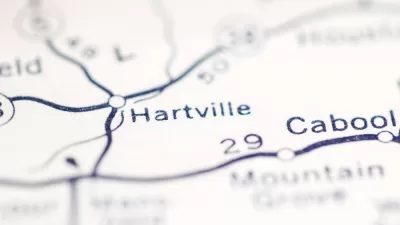The U.S. Census Bureau yesterday released its first set of apportionment population and resident population counts for the nation and each state.

The first big data release of a Census process troubled by politics and a pandemic went public this week. The 2020 Census apportionment results seem almost tailor-made to add fuel to the fires of polarization and culture war , as the nation's growth slows to a historic crawl and population shifts to Republican-led states in the South and West—and away from long-time growth machines like California and New York.
A ton of news and analysis has been generated in response to the announcement, so before providing an link dump, here's a look at a few of the dominant narratives that has emerged in response to the data release.
U.S. Growth Slows
The growth rate of the population in the United States was slower between 2010 and 2020 than it has been since the 1930s. Despite total U.S. population growth outpacing some previous estimates, the reality in 2020 was far from the "population bomb" theory of environmental and social concern popular at the end of the 20th century. Still, population is primed to decline in the coming decades, and unless there's a post-pandemic baby boom, the country could be entering a period of population decline much sooner than anyone could have imagined even a few short years ago.
Census Reflects the Nation's Political Fragmentation
The reapportionment data has an obvious effect for the political realities of the United States, and the list of states that won seats (Texas, Florida, and North Carolina lead the list with two, one, and one new seats, respectively) versus the states that lost seats (California and New York lost one seat, along with Illinois, Pennsylvania, and Michigan) breaks down almost too cleanly along the political fault lines that have divided the country in recent years. This zero-sum game of winners and losers is also reflected in the quick work some urbanists made of weaponizing the new Census numbers as evidence for the cause of developing more housing. Still, while some see the shifting Census data as evidence of a victory for the Republican party, others see an opportunity for liberals to make the case for allowing new levels of immigration. Also, there is already evidence that the Republican-supporting track record of the states that gained new House representatives are shifting toward Democratic candidates as their populations grow.
Crisis of Confidence
The state of New York, home to the nation's most populous and culturally magnetic city, lost the final seat in the House of Representatives by a difference of 89 people—despite growing its population by 4 percent. The New York Times tied the loss of the seat to political dysfunction and an undercounted Census process, but others wondered what would have happened if there had been 89 fewer "Why I'm leaving New York" essays published on the Internet. The state of New York's number of House representatives has been declining since the 1940s, at least. California had never lost a seat in the House until now. Like with New York City, many on social media are blaming California's loss, also achieved despite a growth in population, on out-migration caused by the high cost of housing in the state. The New York Times, however, blamed the state's slowing growth on declining birthrates and changing federal immigration policies.
With those three narratives in place, here's a list of initial reading on the apportionment and population data release this week. The links below include the embedded links above as well as more local, state, and national coverage of the new Census data. Hat tip to All Things Census for such consistent sharing of Census stories.
- A Preliminary Analysis of U.S. and State-Level Results From the 2020 Census (U.S. Census Bureau)
- Blog: 2020 Census Apportionment Data Released (Kem C. Garder Policy Institute)
- 2020 Census shows U.S. population grew at slowest pace since the 1930s (The Washington Post)
- US marks slowest population growth since the Depression (Associated Press)
- Which States Won — And Lost — Seats In The 2020 Census? (FiveThirtyEight)
- New census numbers shift political power south to Republican strongholds (The Washington Post)
- Some bad news about our future gives Biden a big opening. Will he seize it? (The Washington Post)
- New York Loses House Seat After Coming Up 89 People Short on Census (The New York Times)
- Why California’s Growth Has Slowed (and Why Demographers Aren’t Surprised) (The New York Times)
- 2020 Census results: Georgia has packed on a million more people (Urbanize Atlanta)
- Apportionment in the United States (Beeck Center for Social Impact and Innovation)
- Census: California, Northeast, Midwest lose House seats (Roll Call)
- A Few Surprises in the First 2020 Census Results (Demo Memo)
- 1st census numbers released, setting up contentious redistricting cycle (Good Morning America)
- Census: NY population rises 4% but state will still lose congressional seat (Newsday)
- Census 2020: First results show near historically low population growth and a first-ever congressional seat loss for California (Brookings)
- Video Clip: 2020 Census and Apportionment Results (C-SPAN Classroom)
- These charts show what we learned from the 2020 Census (The Boston Globe)
- The next census fight (Axios)
- How the 2020 census affects Washington’s balance of power (PBS)
- Wisconsin to keep eight U.S. House seats after latest census (The Capital Times)

Montreal Mall to Become 6,000 Housing Units
Place Versailles will be transformed into a mixed-use complex over the next 25 years.

Planetizen Federal Action Tracker
A weekly monitor of how Trump’s orders and actions are impacting planners and planning in America.

DARTSpace Platform Streamlines Dallas TOD Application Process
The Dallas transit agency hopes a shorter permitting timeline will boost transit-oriented development around rail stations.

Without International Immigrants, the Rural US Population Would Be Falling 58%
Census data shows that population growth in rural areas is due in large part to international migrants.

Dead End: Nine Highways Ready for Retirement
The Freeways Without Futures report describes the nation’s most promising highway removal proposals.

Congressman Proposes Bill to Rename DC Metro “Trump Train”
The Make Autorail Great Again Act would withhold federal funding to the system until the Washington Metropolitan Area Transit Authority (WMATA), rebrands as the Washington Metropolitan Authority for Greater Access (WMAGA).
Urban Design for Planners 1: Software Tools
This six-course series explores essential urban design concepts using open source software and equips planners with the tools they need to participate fully in the urban design process.
Planning for Universal Design
Learn the tools for implementing Universal Design in planning regulations.
City of Mt Shasta
City of Camden Redevelopment Agency
City of Astoria
Transportation Research & Education Center (TREC) at Portland State University
City of Camden Redevelopment Agency
Municipality of Princeton (NJ)
Regional Transportation Commission of Southern Nevada






























